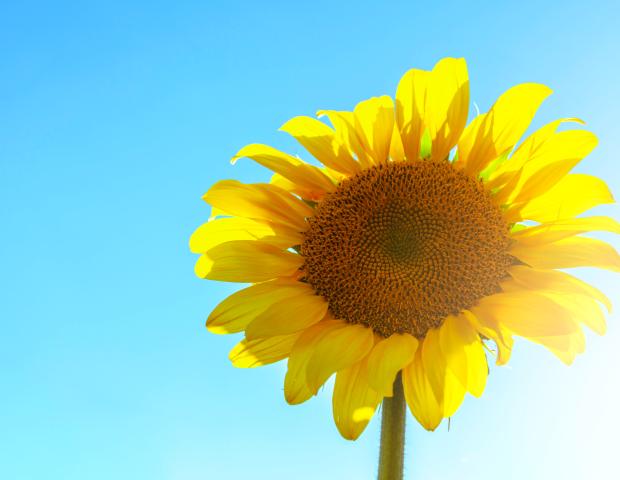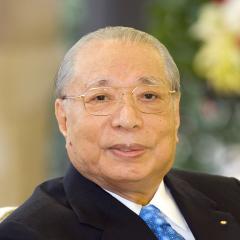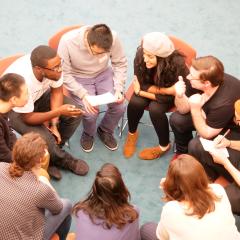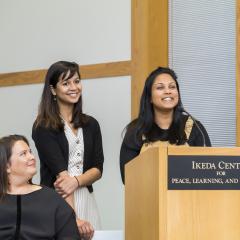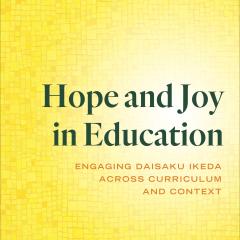Dimensions of Daisaku Ikeda's Philosophy of Hope
In 2017, Middleway Press published an edited volume of highlights from Daisaku Ikeda’s extensive philosophical writings. Because it was the theme of hope that stood out the most, the volume was titled Hope Is a Decision. Shortly after publication, we asked Jeff Farr to reflect on Daisaku Ikeda’s philosophy of hope as found in the book and to share his thoughts with us. His response was this inspiring look at what he sees as Daisaku Ikeda’s seven most essential teachings on hope, especially as they relate to young people.
1. Hope is found within
Ikeda views the true source of hope as the internal life of the individual. Of course, external influences, like caring parents, great teachers, and empowering experiences are crucial to awaken or strengthen this inner hope. But for Ikeda, the external cannot do anything for the individual unless the hope has already been waiting there, even if deep inside, unless the hope is part of our human DNA.
At the same time, according to Ikeda, nothing external can ever completely extinguish hope—no terrible family situation, no bad teacher, no horrific experience. Ikeda clearly wants young people to realize this basic point: No one is going to “give you hope,” and no one can ever take your hope away once you have it.
He also wants young people to know that they themselves are hope—the aforementioned hope of the nation, for instance. Ikeda probably never heard anything specifically like this hopeful message as a child, unless it was from his mother, who had a simple way of encouraging a boy who so often struggled with illness. He shares in Hope Is a Decision how his mother once likened him to the pomegranate tree growing in their yard: “Look at that pomegranate tree. It’s supposed to dislike salt, wind, and sandy soil, like what we have around here, but still it blooms and bears fruit every year. You may be weak now, but you’re sure to grow strong someday” (pp. 109–10).
The majority of what Ikeda heard in school was how great it was to be Japanese, a “superior race,” and how great it was to serve, even sacrifice one’s life for, the Japanese emperor. Without telling his parents, Ikeda volunteered to serve in the youth air corps, in which he would likely have become a Kamikaze. Fortunately, his father found out and put a quick stop to it.
It was not until after the war, when Ikeda first met his teacher, Josei Toda, that he heard the clear message that hope exists within—that he himself, at age nineteen, was a great hope for the future.
2. Hope grows when you share it
In Ikeda’s view, hope is nothing like a secret you keep to yourself. That would go against the true nature of hope, which is to move from within to without, from one person to another and another in wider and wider circles. Hope is something that must by nature be shared. The sharing strengthens it.
Perhaps we could even say that hope that is not shared, hope that stays somewhere hidden, is not truly hope. Maybe it is only a dream, a fantasy; maybe it is only a selfish wish.
For Ikeda, there is nothing all of humanity shares more than hope—the hope for world peace being the prime example. In Hope Is a Decision, he writes: “We must open the way to a century without war, a century of peace. This, I believe, is our destiny and mission” (p. 4). Hope, destiny, mission: These inextricably bind us and can free us.
I should note that while Ikeda is a Buddhist of deep faith, his Buddhist philosophy and practice have led him to the conclusion that the great world religions have no choice but to transcend their differences and work together. Buddhism that separates itself from the other religions is no longer Buddhism, he believes. He has put this principle into action by engaging in numerous in-depth dialogues over the decades with leading figures from all the other religions, as well as with like-minded, peace-oriented thinkers who are non-religious.
One of the essays here, “A Path Called Dialogue,” details Ikeda’s dialogues in the early 1970s with the venerable historian Arnold Toynbee, who was a Christian. Ikeda and Toynbee found that they sought the same thing: for humanity to share deeper interaction with what Toynbee deemed the “ultimate spiritual reality.”
Ikeda explains: “We arrived at the shared conclusion that the best description of this ultimate reality was a law inherent in the life of the universe. The philosophical quest of Toynbee, a Westerner, had much in common with the Buddhist wisdom of the East” (p. 97).
Ikeda has in recent years endorsed the view of religious scholar Harvey Cox that Buddhism could be an effective bridge between Christianity and Islam, since, unlike those religions, it is non-theistic, thus lending it more flexibility in finding points of agreement. The underlying idea, again, is that religions should focus on what they share, which would be, above all, a striving for hope.
If religions unite around hope, share hope, then nothing can ever stop hope.
3. Hope grows when it is tested
Ikeda often makes the point that hope grows stronger when put to the test. A hope that takes longer to realize, for instance, is a much stronger hope than one instantaneously realized, one likely forgotten after coming to easy fruition.
In fact, a hope that takes longer to realize may keep growing and growing and never stop. Things can always get better in the realm of hope; there really is no endpoint.
What can turn a small hope into a bigger hope? Resistance, trouble, situations requiring patience and persistence, Ikeda says. He never forgets something Toda once wrote that inspired him in his youth: “In looking at great people of the past, we find that they remained undefeated by life’s hardships, by life’s pounding waves. They held fast to hopes that seemed mere fantastic dreams to other people” (p. 6).
How can young people learn to “hold fast to hopes”? People today, not just young people, tend to discard their hopes rather easily, even carelessly. This is exactly where hardship comes in—it can be a great teacher, an education. We sometimes call it the School of Hard Knocks.
Ikeda thus feels that youth should, within reason, seek out or welcome hardships. What better way is there for them to increase their natural sense of hope?
He writes: “Sometimes, it may be hard to see where—or how—to begin. But we cannot be paralyzed by despair. We must each take action toward the goals we have set and in which we believe. Rather than passively accepting things as they are, we must embark on the challenge of creating a new reality. It is in this effort that true, undying hope is to be found” (p.7).
He certainly lived his own youth this way, despite a doctor’s evaluation that he would not live past his mid-twenties. Even Toda thought Ikeda would not live past thirty.
Ikeda credits working for Toda—building his young life around rebuilding Toda’s business enterprises—as the thing that ultimately saved him: “Because I knew that I had a job to do, both my body and my spirit rose to the challenge. Eventually, I regained my health” (pp. 25–26).
4. Hope grows through bigger hopes
Another consistent message in Hope Is a Decision is that “real hope is found in committing ourselves to vast goals and dreams—dreams such as a world without war and violence, a world where everyone can live in dignity” (p. 7). If we feel we are lacking in hope, perhaps our hopes are just not big enough, Ikeda suggests.
Does this contradict his earlier point about finding hope within? Is this a form of trying to find hope outside ourselves, trying perhaps halfheartedly to make the big hopes our own?
Ikeda’s point is to also find these bigger hopes inside ourselves—to find our own dream for world peace, for instance. It is not a hope we hold to just because it is the right hope to have.
He believes that the hope for world peace and the other great hopes of humanity are intrinsic to each of us, and we each have our own way of expressing them. We may not feel this way at first, but this is why Ikeda emphasizes “digging deeper within” (p.6).
You may have noticed Ikeda’s term “real hope” above. He leaves it to the reader to ponder what “real hope” could be, but it is clear that for him there is a big difference between “real hope” and…what would be its opposite? “Fake hope,” “pretend hope,” “weak hope”? There is also, of course, just plain hopelessness.
At any rate, the opposite is something “less than real.” In fact, there may be many forms of “less than real” hope, and we may be inundated with them today.
Nationalist hopes could be one example. Ikeda remembers how his peers felt after World War II: “For my generation, which had nationalism and absolute obedience to the emperor drummed into us from the time we were old enough to understand anything, it seemed as though everything we had believed had suddenly been reduced to naught. We had nothing whatsoever to trust and believe in. It is hardly surprising that we found our bodies and minds tormented day after day by distress and apprehension” (p. 16).
“Less than real” hope can in this way become a dangerous, harmful thing, especially for young people pushed or literally forced to embrace it.
5. Hope grows when we value life itself
Ikeda relates deeply to something Miguel de Cervantes wrote in Don Quixote: “While there’s life there’s hope.” When Ikeda struggled with illness in his youth, he used to tell himself, “I’m still alive, which means there is still hope!” (p. 26).
How many people actually think this way? We too often make the mistake of taking the simple fact that we are alive for granted. But if we are alive, the story is not over; things can still change for us; we can still change; anything can still happen.
Although it is more myth than reality, we have in our popular culture the sadly enduring image of the ruined financiers jumping to their deaths in 1929 after the stock market crash. Part of the story is that those poor souls could not see that the Great Crash, as bad as it was, was temporary. On the other side of the Great Crash and the Great Depression was financial hope (and a different set of challenges). If these men could only have seen their own lives as hope, they would have eventually recovered.
We see this kind of disregard for our own lives in the current epidemic of drug overdose deaths, now the leading cause of death among Americans under fifty. I recently read about one Ohio county that in 2016 had to request refrigerated trailers to store bodies after the morgue had already filled up with drug deaths. While most of the overdoses are accidental (due to fentanyl), the epidemic of addiction leading up to the overdoses in many, or at least some, cases has much to do with forgetting—or never learning, never believing—that to still be alive in the world is hope itself.
For Ikeda, self-respect and hope go hand in hand.
Ikeda shares in Hope Is a Decision that, in addition to Cervantes, he has been an avid reader of Walt Whitman. I once heard Ikeda share in a speech these words from Whitman: “My real self has yet to come forth…. It shall yet stand up the soldier of ultimate victory.” This is a great American-style expression of the same hope that Ikeda advocates.
First, we have Whitman’s deep belief in his “real self”—he believes that he has it within him, he believes in his own life.
Second, we have his belief that his “real self” is going to manifest more, that it is “yet to come forth”—he knows that he is going to keep becoming more and more himself as he lives his life, so watch out!
Third, Whitman believes that this is how he is going to win in life, through the power of self: The “ultimate victory” will not be denied him.
We could say that this line of reasoning goes something like this: I am real. I will become more. I will win through my own realness.
6. Hope grows with great teachers
Through what Ikeda tells us of Toda, it is obvious that Ikeda’s definition of a great teacher is one who has solid hope in his or her students, a teacher who can, based on his or her own hope, awaken the hope already within each student’s heart. It might sound funny, but a great teacher, then, is one who has the hope that the hope inside each student is definitely present.
Ikeda thus writes: “It is not too much to say that, in the end, everything I have today I owe to the fact that I encountered such a great teacher, one who was willing to trust me without question. To be looked upon as trustworthy and reliable is surely one of the most valuable assets a person can have, regardless of occupation” (p. 28).
For Ikeda, hope and trust go together: Hope leads to trust, trust leads to hope; hope is a kind of trust, and vice versa. Trust in self is key, but it can be awakened by family, by teachers, by experiences, by life.
Ikeda urges his young readers to seek out teachers and experiences, like he did, that push them to trust their own instincts, to self-reflect, to act with courage when the time comes. These are all essential elements to establishing a self-sustaining hope. This hope is both something intrinsic and something learned—something intrinsic that young people can learn how to better employ.
7. Hope is a decision
This is the title of the book, and we are back where we began. But what does this idea really mean to Ikeda?
He explains that “when we change our inner determination”—a process he has often called human revolution—“everything begins to move in a new direction. The moment we make a powerful resolve, every nerve and fiber in our being will immediately orient itself toward the fulfillment of this goal or desire” (p. 4).
The decision Ikeda is talking about, then, is not a light decision—it is more like a determination, a promise, even a vow. The challenge for young people and for all of us is to get to that inner place where we can make the new determination and stick with it. And to go through this process again and again as we go through life and face many challenging situations. It is not so easy because the world as it is can sometimes wear us down—even without that chorus of discouragement pervading contemporary discourse.
Which is why we need poetry, or a poetic spirit. The decision, the determination, is a poetic decision, a poetic determination, Ikeda suggests throughout Hope Is a Decision. The decision is a kind of poetry. Hope is poetry.
Civil rights veteran Vincent Harding explains this well in his dialogue book with Ikeda, America Will Be!: “Poetry can remind us that we have the capacity to create—the capacity of telling and understanding our stories. But its role does not stop there. It stimulates us to take on the task of imagining a new future—an essentially poetic task.
“It may be that we should not try to describe the future simply in ordinary prose, scientific paragraphs, or straight statements of proof. Maybe we should express it in poetry because this may be the best bridge we have between that which exists and that which is yet to come.”
In Hope Is a Decision, Ikeda shows us that “deciding for hope,” as scholar Sarah Wider puts it in her “Foreword,” is a spiritual challenge, a challenge of the spirit, and thus inherently poetic. Whenever youth take up this challenge and all of us support them in doing so, hope commands the times.
Ikeda writes, “At one time, perhaps, all people were poets” (p. 60). What he means, I think, is that it can happen again.
